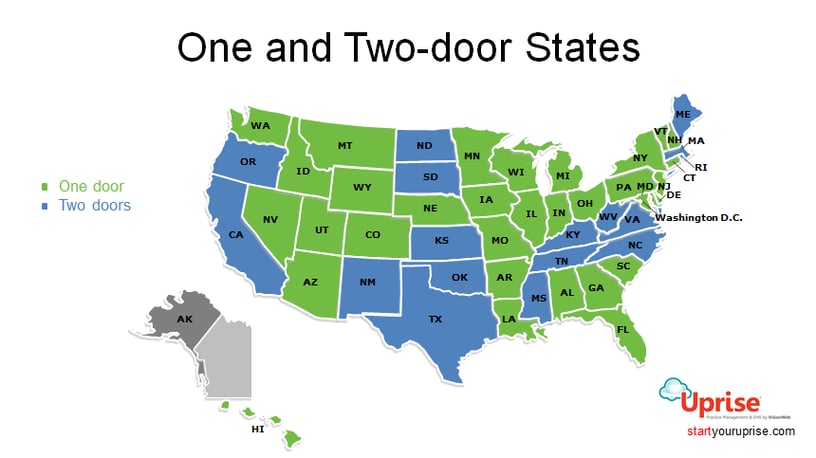The Difference of Working in a One-door vs. Two-door State
We were talking to Dr. Maria Sampalis from Corporate Optometry Careers about one-door and two-door states, when it occurred to me that there is not a lot written on this topic aside from state regulations dripping in legalese.
If you're thinking about a career in a corporate practice, which is a great option for new ODs, it helps to understand what your business will look like under either model. Then, you can establish which state you'd want to set up shop.
A Quick Overview of One-door vs. Two-door States
A one-door state is one in which the independent optometrist operates inside or adjacent to an optical center. The doctor can take advantage of some shared services like appointment setting, Internet, and possibly some marketing assistance. As an OD it will be your job to build a great working relationship with your optical partners for the business to run smoothly. The downside is that you might not have a lot of control over your hours and the corporation may exercise more control over your practice than you're prepared for.
In a two-door state, the OD is entirely separate from the optical center including physical wall separations and all other services. The theory is that keeping the clinical and retail sides separate will benefit the customer. Two-door doctors may have more flexibility on hours, freedom to do things their way, and benefit from great pay.
As a marketer, I like the idea of owning my patient data. If I were to leave the practice, I would want to take my patients with me. That's harder to do in a one-door state, particularly if the organization you lease from provides the appointment setting.
The choices are overwhelming when it's time to start a career. If you're thinking about going down the corporate path, ask a lot of questions. Here are a few that come to mind:
- Who is responsible for phone, Internet, exam equipment, furniture, decor?
- Who schedules appointments?
- Do I need to use a certain EHR, practice management, clearinghouse, or point-of-sale system?
- Who collects patient payments?
- Who bills insurance?
- Am I allowed to sell products?
- Do I set my own hours?
- Can I select my technicians and staff?
- What benefits are available for my staff and me?
- What kind of individuals are successful in this setting?
- Does the corporation offer any discount programs for my practice?
With some crowd-sourcing from Dr. Sampalis's Facebook Group, we drew this map that shows which states are one-door vs two-door. Each state might have exceptions for their regulation, so you should consult the Corporate Optometry network for specific advice. If you're a corporate OD in Alaska, let us know the status of your state!

Ultimately, what we love about our industry are all the options for using your education to design the career you want. You can take a corporate route, join academia or research, work in a government or hospital setting, start your own practice, acquire an existing practice, join an established practice, buy a franchise, work with an industry tech company, or even help develop software for optometry like we do. There is something for everyone and a lot of options for making your career work for you.
For more useful career tips, subscribe to the Uprise blog.

